Test – Gigabyte X99 Gaming 5: Specs | Price | CPU | Profitability| Hashrate| best Coins | Config | Advantage (Pros) and Disadvantages (Cons) and other important features that will help you make better decision.
After the test of the very good Gigabyte Z97X Gaming G1 Wifi-BK (here) I will present the X99 Gaming G5, still from Gigabyte. Who says X99 chipset says high-end configuration based on core i7 6 or 8 cores and DDR4 Quad Channel so the Gigabyte X99 Gaming 5 is not for everyone, only the wealthy and needing a lot of power will be likely to be interested.
Offered at a price of around € 250 it is in the mid-range of X99 cards, however, it will be necessary to invest at least € 250 in a 4 x 4 GB DDR4 kit and € 360 in the most affordable of processors, the core i7 5820K. Let’s see what the little one has in the stomach!
Specification: Gigabyte Z97X-Gaming G1 WiFi Black Edition
| Gigabyte Z97X-Gaming G1 WiFi Black Edition | |
|---|---|
| Format | ATX (30,5 cm x 24,4 cm) |
| Socket | Intel 2011-3 |
| CPU | Intel Core i7 Haswell-E or EP |
| Chipset | Intel X99 Express |
| Memory | 8 x DDR4 2133 Mhz “Quad Channel” Support XMP 2.0 Maximum de 64Go |
| Slots d’extensions | 2x PCIe 16X (work in 16X) 2x PCIe 16X (work in 8X) 3x PCIe 1X 1x M.2 socket |
| Multi-GPU | AMD CrossFire 4 Way nVidia SLI 4 Way (3 Way only with a Core i7 5820K) |
| Audio Chipset | Creative® Sound Core 3D TI Burr Brown® OPA2134 operational amplifier |
| Network | 1 x Qualcomm® Atheros Killer E2201 (10/100/1000 Mbit) |
| Wireless network | Non |
| Number of connectors for fans | 5 |
| Storage | Intel X99: 1 x M.2 PCIe 1 x Sata Express 10 x SATA 6Gb/s Support RAID 0 / 1 / 5 / 10 |
| USB | Back panel: 6 x USB 3.0 4 x USB 2.0 Internal connectors: 2 x USB 3.0 4 x USB 2.0 |
| Video outputs | Non |
| Price | ~ 250€ |
As we can see we are dealing with a good big motherboard well filled, socket 2011-3 hosting the latest Intel Core i7 Haswell-E or EP (5820K, 5930k, 5960x and Xeons) in standard ATX format. On the other hand, the card only accepts DDR4, 8 slots are available for a total of maximum 64 GB of RAM, native DDR4 2133 but overclockable up to 2800 MHz.
In terms of PCIe ports Gigabyte sees things in a big way with 4 16x ports (2 wired in 16X and 2 in 8X) which will allow SLI / Crossfire up to 4 cards except for the small Core i7 5820K which will not support the SLI only on 3 cards maximum.
The X99 Gaming 5 is not left out in terms of integrated components with a sound part isolated from the rest of the motherboard driven by a high-end Creative Sound Core 3D chipset, high-end dedicated capacitors as well as a Texas amplifier. Burr Brown® OPA2134 instrument which should eliminate the need for a high end third party sound card.
The network part is entrusted to an Atheros Killer E2201 chip (supposed to reduce the ping and everything, which is in fact only a prioritization of the applications) which is of course capable of providing 1 Gb / s.
Regarding storage there again there is what is needed, 10 Sata 6Gb / s ports managed by the X99 chipset (with Sata Express compatibility) and 1 M.2 PCIe port which will be perfect for stalling a small family SSD ( like the Plextor M6e 128GB tested here).
Priced at around € 250 the Gigabyte X99 Gaming 5 is located in the mid-range of this type of motherboard, it should be an excellent choice if the tests prove to be conclusive, let’s see that!
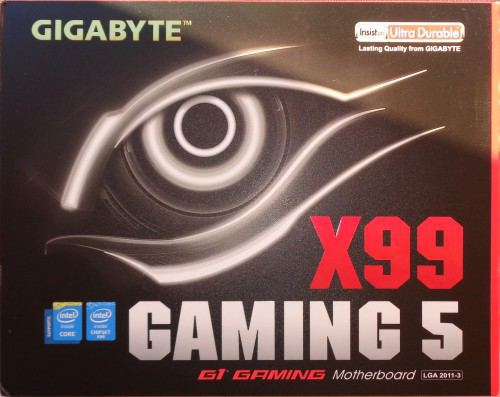
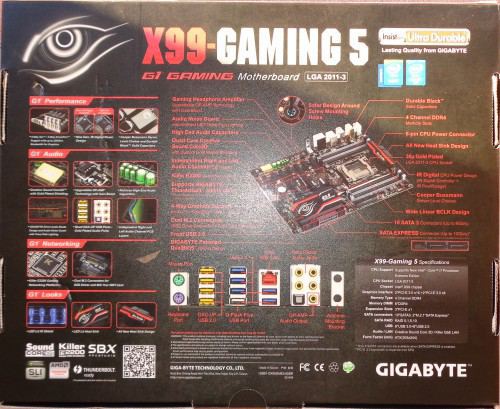

The box is not in the lace, a shiny black grainy coating is present which gives an impression of high-end, we find the logo of the brand, the model of the motherboard as well as the eternal Intel logos and the mention “Ultra Durable ”which shows that the card is equipped with high-end capacitors.
At the rear there is a view of the motherboard with the main strengths as well as the specifications and a photo of the rear connectors.

When opened, we fall directly on the motherboard, in its antistatic packaging and in an individual box.

Under the motherboard we find all the goodies present, as much to say that there is a bunch of things, let’s see what the bundle contains:
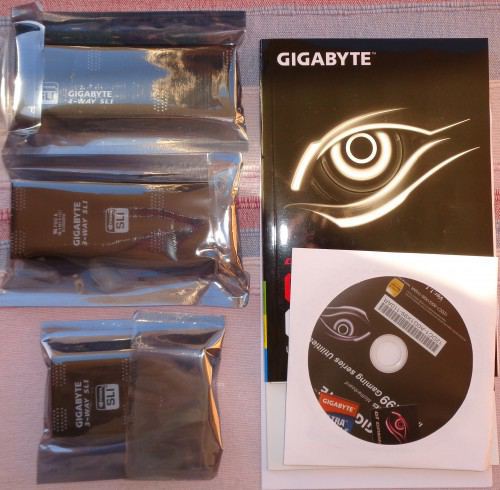
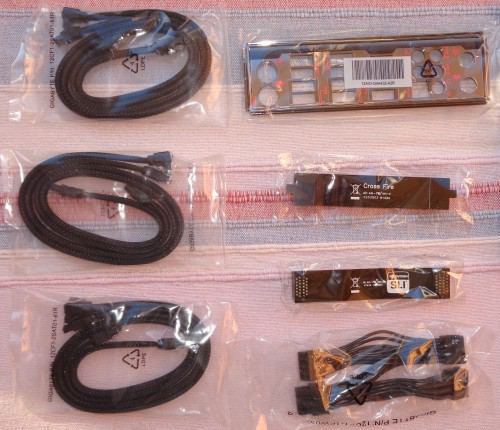
The bundle consists of:
- The manuals and the driver CD
- 1 x illuminated I / O panel
- 1 x pont Crossfire
- 1 x Soft SLI Bridge, 2 x 3-Way SLI Bridge in Different Sizes, 1 x 4-Way SLI Bridge
- 1 x adaptateur 3 x 8-pin CPU -> 1 x 8-pin CPU
- 6 x Sata 6Gb / s black braided cables
As we can see Gigabyte does not skimp on accessories, especially when it comes to multi-GPU bridges which cover all possible configurations, the bright I / O panel will make connecting peripherals to the back less frustrating than blindness and braided Sata cables are really nice little things. On the other hand, a curiosity creeps into all this, the adapter 3 x 8-pin CPU (female) -> 1 x 8-Pin CPU (male), but) what can it be used for? After careful consideration, I would say that it serves to fortify the power supply to the CPU in case we have a power supply equipped with several of these connectors, given that the Core i7 on socket 2011-3 can be abysmal in terms of consumption. there may or may not be an interest.
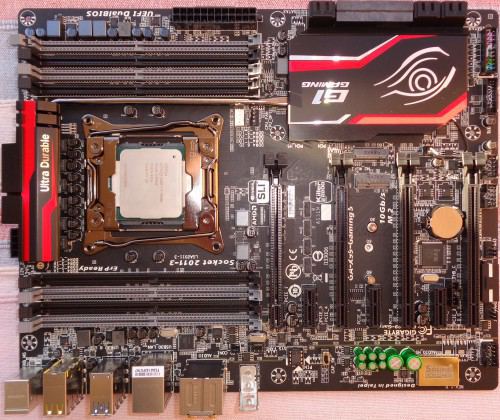
Here is the beast! As usually black and red are used to mark a “gaming” use, we do not know why these colors represent components specially designed for the game, and we do not want to know! The X99 Gaming 5 is pretty busy, there isn’t much room left to add components! The 2 radiators are connected to each other by a heat pipe, the small one next to the processor being responsible for cooling the VRMs the fact of evacuating a little heat towards the one behind the PCIe ports can not hurt.

At the back we always find a matte black PCB that exudes quality, all the radiators are fixed with screws like all high-end motherboards to ensure a longer life.
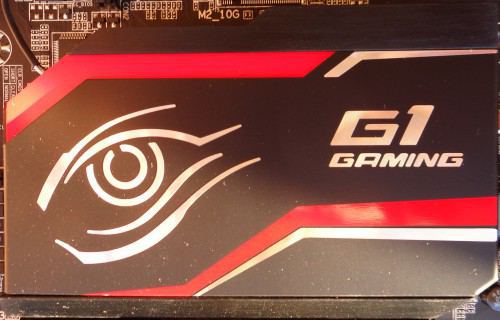
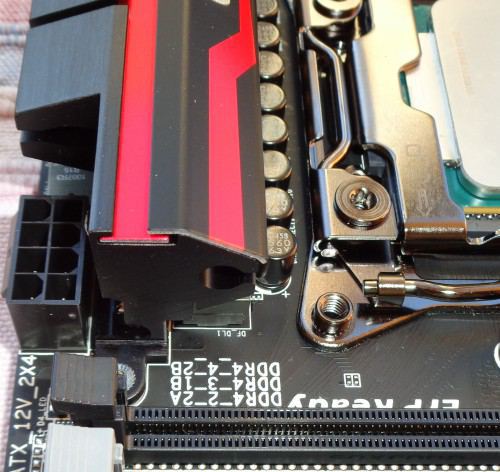
The radiators are a good size and very thick in order to dissipate a maximum of heat, in particular that of the VRMs.
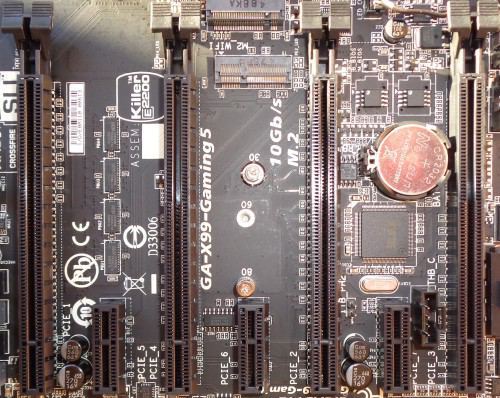
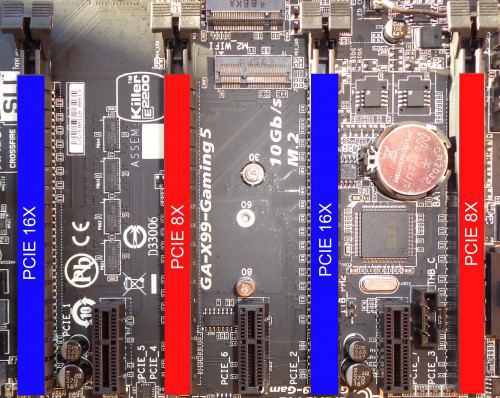
The card is equipped with 4 PCIe 16x ports, 2 of them are cabled in 16x (in blue) and will also work all 2 in 16x during a crossfire or an SLI, the others are cables in 8x (in red) . Naturally, to have the best results when using more than one graphics card it will be preferable to install the cards in the blue ports, even if the difference in performance between 16x and 8x will be undetectable.

Particular attention has been paid to the sound part of the Gigabyte X99 Gaming 5, in fact we have the right to a dedicated part isolated from the rest of the card, a Creative Sound Core 3D chipset, high quality capacitors and an amplifier Texas Instrument, as much to say that the sound will be really excellent for the integrated sound. The switch (to the left of the green capacitors) increases the amplification of the microphone / headphone outputs from 2.5X (original) to 6X for headphones that have a high impedance (like the Sennheiser G4me Zero tested here).
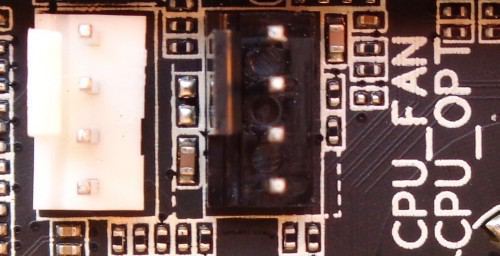



In terms of ventilation, the X99 Gaming 5 has enough connectors, namely 3 connectors for the case fans and 2 for the processors, all PWM of course.

No need to draw you a picture here, a good big package of Sata connectors, one of which is Sata Express compatible.

A connector for an M.2 Wifi module (sold separately) as well as an M.2 10Gb / s connector for an SSD.
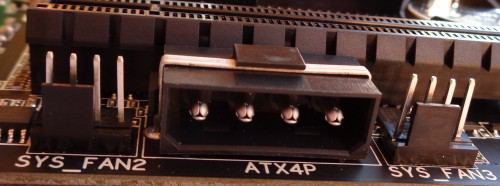
A Molex connector is present between 2 PWM connectors on the edges of the motherboard and which will be useful when installing 2 or more graphics cards to ensure maximum stability.

At the back we have the right to (from left to right):
- 2 x ports PS/2
- 4 x USB 2.0/1.1
- 4 x USB 3.0/2.0
- 1 x RJ-45 Gigabit / 2 x USB 3.0/2.0
- 1 x pannel son
- 2 x slots for the WiFi antenna output (additional card sold separately)
We can say that the number of USB ports is really high on the Gigabyte X99 Gaming 5, not having video outputs helps a lot! I still have doubts about the usefulness of having 2 PS / 2 ports these days.
The lights
A quick word about the bright parts of the X99 Gaming 5, indeed Gigabyte has paid special attention to the look of the card, here’s what it looks like when turned on:
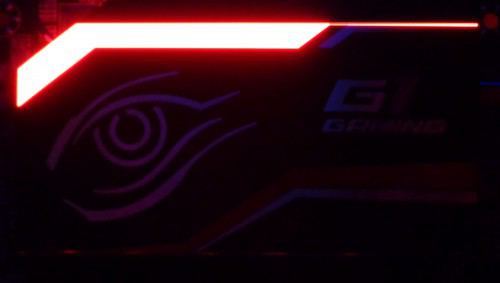


In addition to the light present showing the demarcation of the sound part from the rest of the motherboard the main heatsink is also illuminated. However that is not all as Gigabyte has decided to illuminate the rear panel, indeed it will be easier to plug in the various peripherals, which is really not a bad thing but the resulting light does not make it very. discreet.
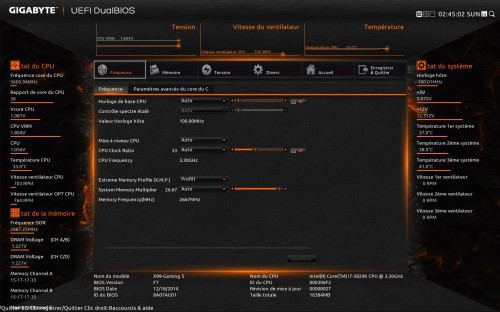
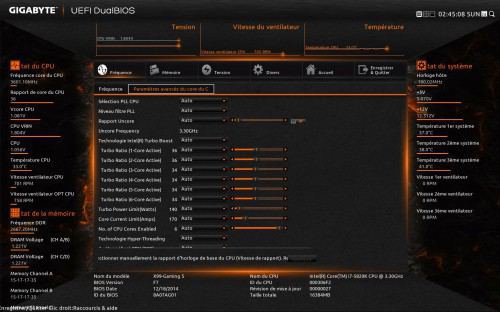
On the left we find information about the processor such as its voltages, temperatures and fan speed as well as memory information. On the right, system information, voltages, processor temperature as well as the speed of the various fans connected.
In the Frequency part it is possible to modify the frequency of the GPU integrated into the processor as well as the processor ratio and activate the XMP profile of the memory. In Advanced Core Parameters free access is left to the user to modify the ratio of each Turbo mode, deactivate / activate cores, modify the consumption limitation etc.
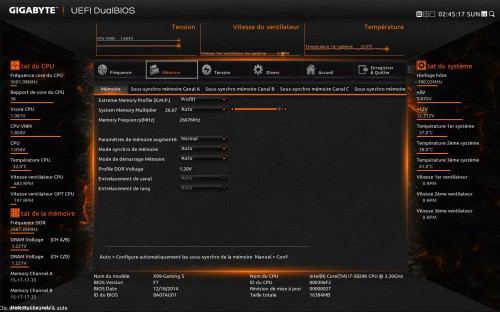
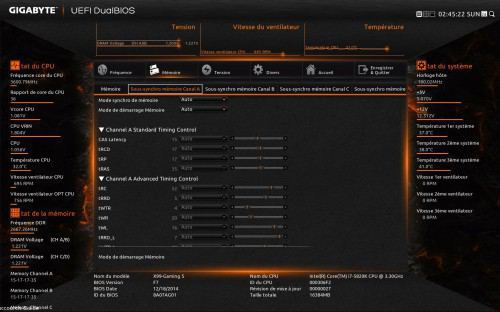
The Memory part as you can imagine is dedicated to the memory, activation of the XMP, modification of the manual frequency, the voltages etc .. and this on each of the 4 different pairs of memories.
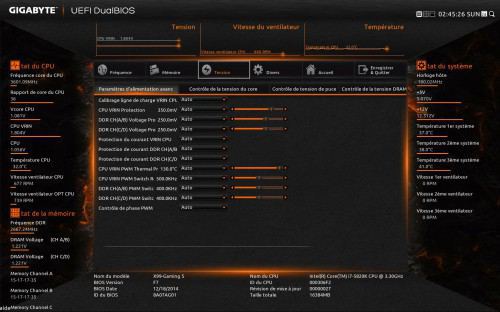
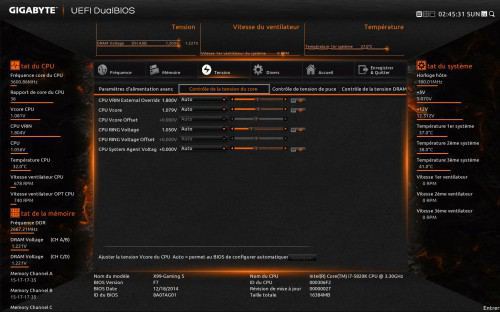
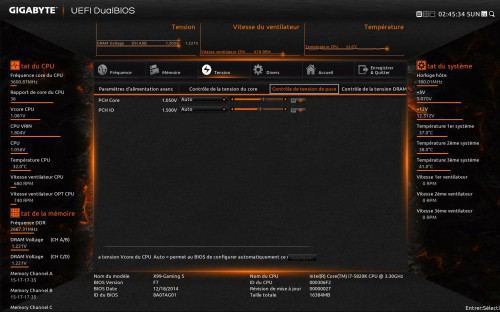
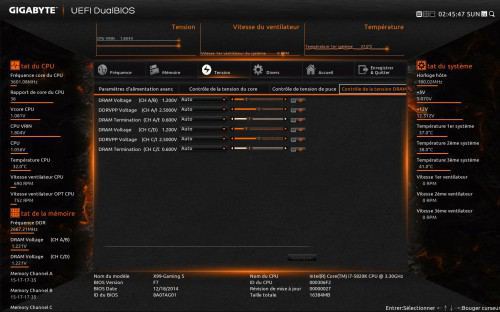
In Voltage we find all modifiable voltages, and there is what it takes to have fun, CPU voltage, chipset and memory. There is definitely something for the more adventurous to do.
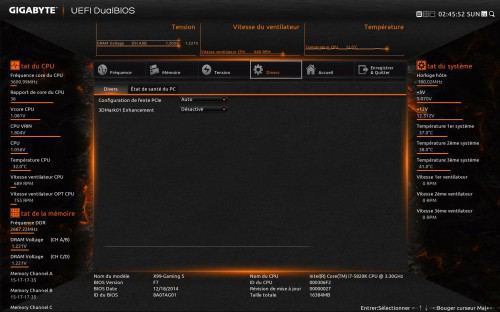
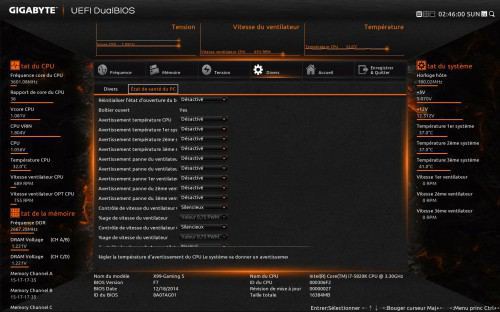
The Miscellaneous section offers some general settings but above all ventilation control. For each fan it will be possible to define ventilation profiles, normal, silent or even manual according to your needs or desires.
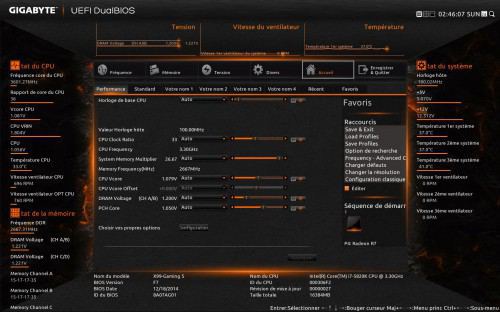
In Home it is possible to manage profiles, the bios options can therefore be saved as you wish on each of the profiles.
In the end, the bios of the Gigabyte X99 Gaming 5 is very complete and will satisfy the most demanding, however there are small concerns of instabilities (on the test configuration at least), from time to time the bios freezes and it is then necessary to restart the machine, the cause is unknown and this problem is encountered only in the bios.
Gigabyte offers us a motherboard with a fairly large panel of software available, without these being essential they can be useful if you want to overclock / adjust your fans / update your bios via Windows. I will take a quick tour of the different software available:
EasyTune
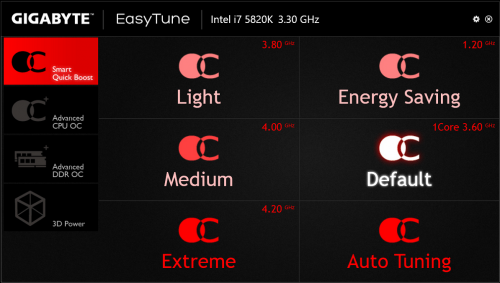
By launching EasyTune it is possible to overclock your processor with a single click, by choosing one of the available presets:
- Light: Overclock 3.8 GHz
- Energy Saving: Downclock 1.20 GHz
- Medium: Overclock 4 GHz
- Default: 3,6 GHz
- Extreme: 4.2 GHz
- Auto Tuning: The software finds the best settings for your configuration on its own
As the name of the software suggests, it’s easy! With one click you can overclock your processor, very good for beginners, but be careful to control the temperatures once the settings have been applied because the software tends to be very large on the voltages applied.
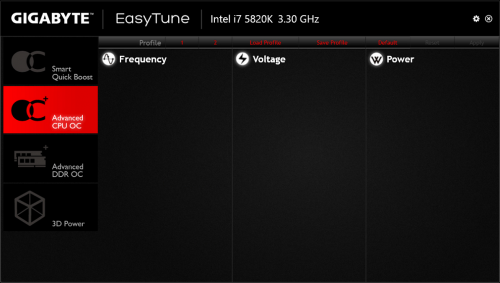
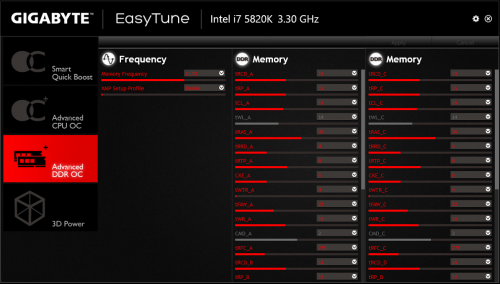
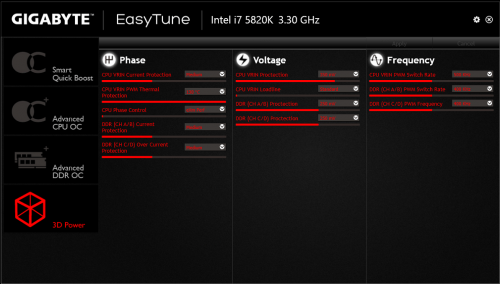
The other 3 tabs are there for finer settings, voltages, memory and more! You have to know what you are doing if you start to touch this, use it at your own risk! Unfortunately at the time of this writing the X99 Gaming 5 is not fully managed by EasyTune therefore the “Advanced CPU OC” tab is empty, you will have to wait for a software update or overclock by the BIOS .
System Information Viewer
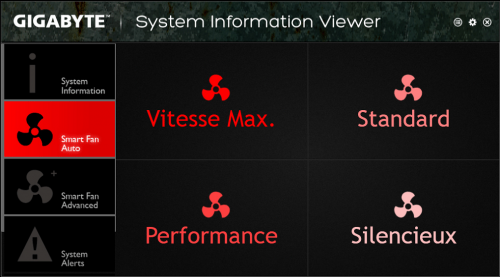
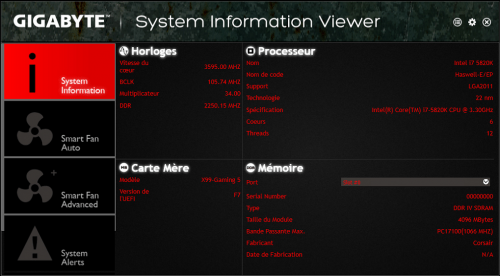
The System Information tab, as its name suggests, presents information about your processor, memory and motherboard.
More interesting, the Smart Fan Auto tab makes the configuration of the fans changeable in 1 click with 4 predefined settings (Performance, Fulls Speed, Quiet, Normal).

This is certainly the most interesting part for any silent pc fan, it will allow you to configure the speed of your fans as you see fit in relation to the temperature of the processor (unfortunately only this temperature). The ventilation curve can be changed and you can make your PC as quiet as possible, or as efficient as possible, according to your desires!
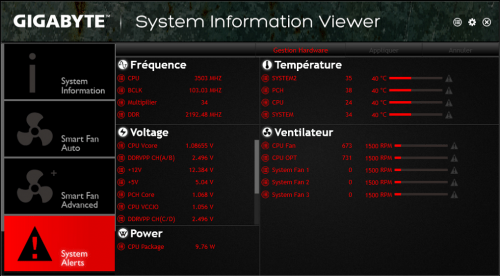
It will also be possible to set alerts according to different settings, for example if the processor exceeds a certain temperature, if a fan goes too low or even a drop in voltage etc.
The test platform
The Gigabyte X99 Gaming 5 has been tested with the configuration below:
- Processor : Intel Core i7 5820K
- CPU Fan : Noctua NH-D15
- Motherboard : Gigabyte X99 Gaming 5
- Mémoire: Corsair Vengeance LPX DDR4 4 x 4 Go 2666 MHz
- Disque dur: WD Raptor 150 Go
- Carte graphique : XFX 7870 Black Edition
- Ventirad Graphics Card : Arctic Cooling Accelero S1
- Alimentation: be quiet! E9 580CM
In order to have results covering a wide range of applications, I chose the following benchmarks:
- Cinebench R15 : downloadable here
- Handbrake : downloadable here
- 3DMark Fire Strike Physics : downloadable here
- SuperPI 32M : downloadable here
- Aida64 4.60 : downloadable here
- Bioshock Infinite et Shogun 2 Total war
- CrystalDiskMark : downloadable here
The motherboard will be opposed to the Gigabyte Z97X Gaming G1 Wifi-BK equipped with an Intel Core i5 4670K, although the processor and the socket are different this will give an idea of the power difference between the 2 platforms.
Cinebench R15
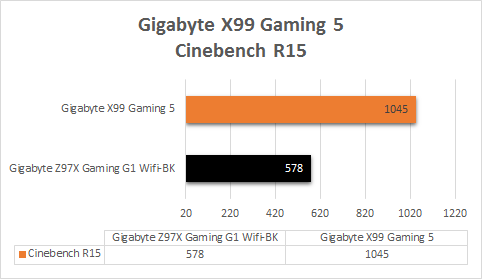
Cinebench is particularly fond of multicore, we go from 578 to 1045 by going from the Core i5 4670K to the Core i7 5820K, the Gigabyte X99 Gaming 5 fulfills its role perfectly.
Handbrake
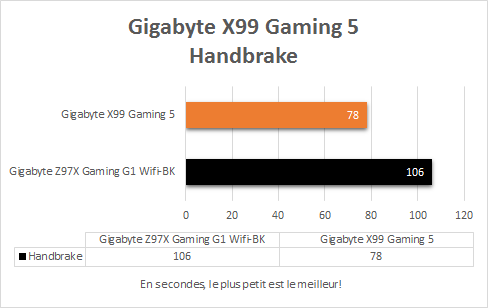
Under Handbrake same result, the application is fond of multicores and we go from 106s for a Core i5 4670K to 78s for the Core i7 5820K of the test, the Gigabyte X99 Gaming 5 is still very powerful.
SuperPI 32M
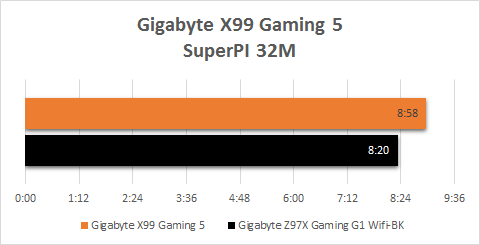
SuperPI32M being a benchmark that only takes advantage of a single core, we see that the Core i5 4670K is faster (3.8 GHz in turbo mode on 1 core) than the Core i7 5820K (3.6GHz in turbo mode on 1 core), the motherboard however did not have any problems, the results are normal!
Aida64 4.60
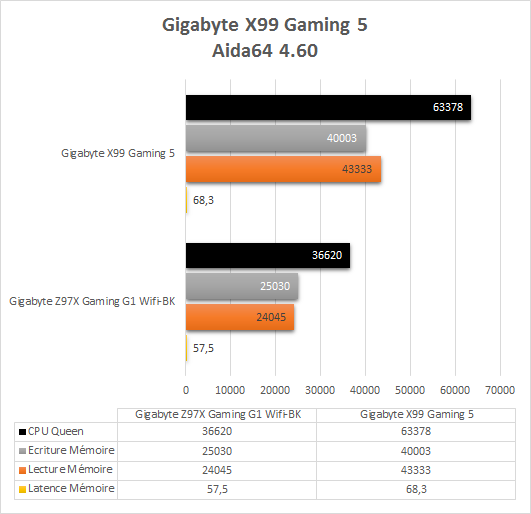
Under Aida 64 the results are unequivocal, the test under CPU Queen with 63378 is light years away from poor Z97X Gaming G1 and its Core i5 4670K.
In terms of memory and even if the “Quad Channel” brings a significant gain in terms of bandwidth, the results are rather mixed, the memory used on the Core i5 being 1600MHz I expected to have a much more gain. important with the use of DDR4 2666MHz. However, we exceed 40 GB / s, which is no small feat!
3DMark Fire Strike and Games
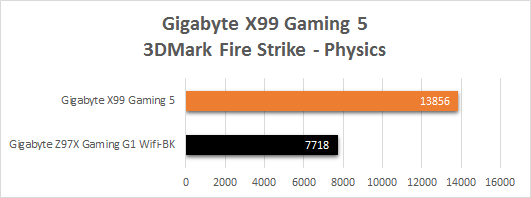
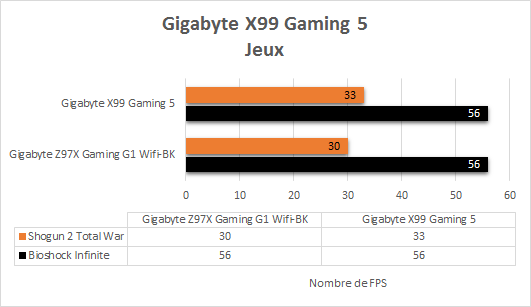
3DMark Fire Strike Physics calculating the pure performance of processors and being particularly fond of multicore we go from 7718 for a Core i5 4670K to 13856 for a Core i7 5820K, which means that on a game using 6 cores the Gigabyte X99 Gaming 5 will be particularly at his ease.
In practice everything will depend on the game, as we can see under Bioshock Infinite which relies mainly on the power of the graphics card the gain is zero while we have 10% gain under Shogun 2 Total War, the gains will be more notable as multi-core games emerge.
Débits Sata – CrystalDiskMark

Since Intel controllers have been very efficient for quite a while now, there is no difference in performance between the 2 platforms, hard disks and SSDs will behave the same with top-notch performance.
Ethernet speeds
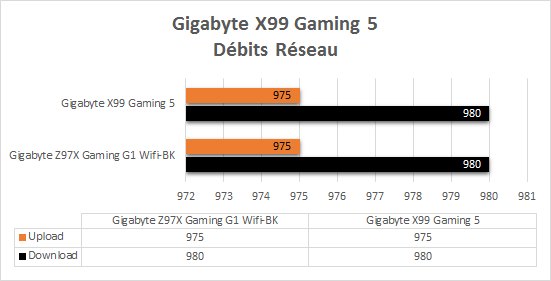
In terms of ethernet speeds, the results are excellent with the Qualcomm Killer chipset, with 975Mb / s in upload and 980Mb / s in download, nothing to say the ethernet network part of the X99 Gaming 5 is efficient. Note that the ping which was supposed to be improved with this chipset and as I have already seen it on other motherboards equipped with the Killer 2201, the results were logically identical, an integrated chipset cannot modify the ping unless to be downloading and that the network driver supports the prioritization of the packets.
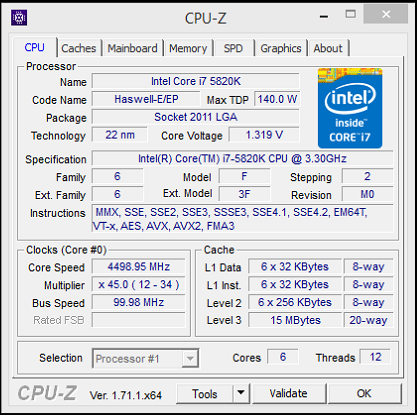
Overclocking was very simple with the Gigabyte X99 Gaming 5, we push the Vcore a little to 1.32V and we put the multiplier coefficient to 45 and we get a Core i7 5820K which runs at 4.5GHz (+ 36%)! Beyond the stability problems appeared and the temperatures soared so I preferred to stop there, which is already not bad. Let’s see the gains that can be expected from such a rise in power.
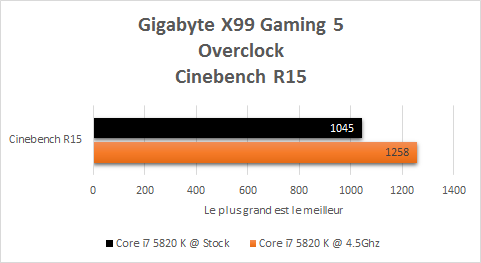
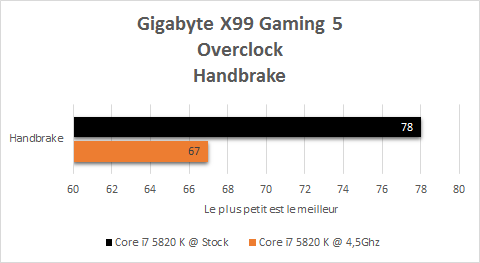
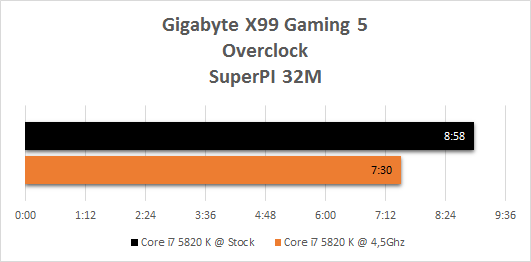
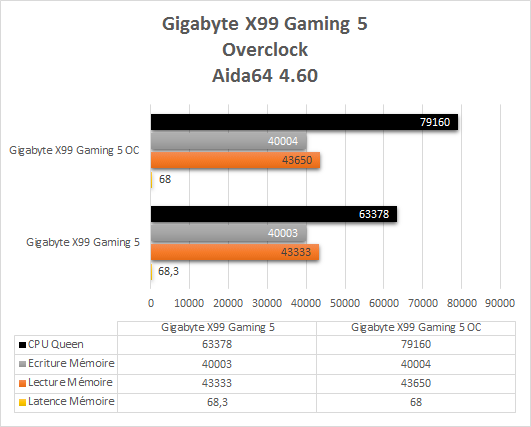
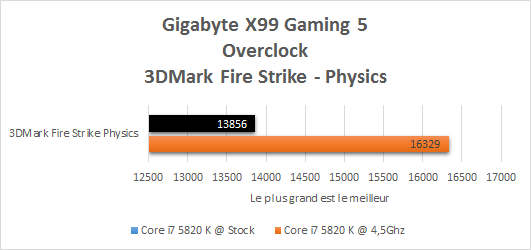
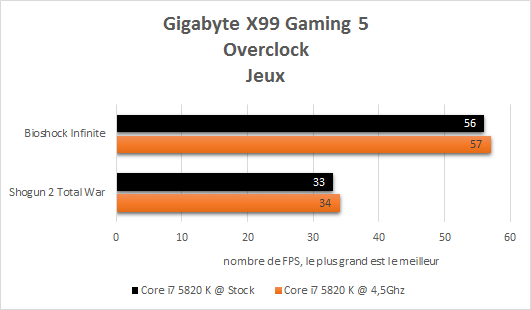
As we can see all the benchmarks are delighted with this increase in frequency, especially multicore applications such as Handbrake and Cinebench, it is clear that the encoding or the calculation software will be in heaven. In games, on the other hand, the gain is marginal, constrained by the graphics card, but this is also the case on a “simple” Core i5.
In the end, the X99 Gaming 5 behaved very well and managed to contain the ardor of a Core i7 5820K overclocked to 4.5GHz (this will depend on the quality of the processor of course) while remaining stable.

Here we are at the end of this test, what about the Gigabyte X99 Gaming 5?
The motherboard is clearly not for everyone, it is designed to accommodate a very muscular PC configuration based on excessive SLI / Crossfire and only accepts very expensive DDR4 type memory for the moment. Overclocking is not to be outdone and it will easily calm the ardor of the rather energy-consuming Haswell-E core i7s.
Offered at around € 250 if you are looking for a 2011-3 socket motherboard for 3D work or if you are a wealthy gamer, want to upgrade to the core i7 6 and 8 cores and want a solid motherboard then it will be a very good one. Good choice.
Advantages
- Build quality
- Overclocking
- Chipset son
- Premium features
Disadvantages
- Small problem of instability in the BIOS
- Purely marketing killer network chipset
A big thank you to Wilfrid from Gigabyte who allowed me to do this test.














